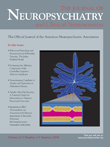Cerebral Venous Sinus Thrombosis May Be Associated With Clozapine
To the Editor: Recent reports suggest that atypical antipsychotics are associated with increased risk of cerebrovascular adverse events, such as stroke, particularly in older people with dementia, 1 though the mechanisms remain unknown. We describe a case of cerebral venous sinus thrombosis likely to be associated with clozapine, which to our knowledge has not been previously reported.
Case Report
A 39-year-old woman with chronic schizophrenia was admitted with a relapse of psychotic symptoms having previously been stable on depot flupentixol for many years. Her psychosis was resistant to increased doses of oral flupentixol and risperidone. Her medications were changed to clozapine, and during the second week of dose escalation (at 100 mg b.i.d.), she developed an acute right hemiparesis and visual field loss. A CT scan several days later showed left parieto-occipital infarction, but the images were degraded by motion. A provisional diagnosis of ischemic stroke was made. Routine biochemical, renal, liver, bone, lipid, hematology, and thyroid profiles; erythrocyte sedimentation rate; C-reactive protein; ECG; chest X-ray; transthoracic echocardiography; and extracranial Doppler studies were normal. Her only vascular risk factors were smoking 20 cigarettes per day and a history of stroke in her father.
An MRI 10 days later showed evidence of thrombus within the sagittal sinus, with left parieto-occipital infarction ( Figure 1 , panels A and B). Clozapine treatment was ceased, and the hemiparesis resolved over 1 month. A repeat MRI 2 months after symptom onset demonstrated recanalization of the sagittal sinus and near-resolution of the parieto-occipital abnormality ( Figure 1 , panels C and D), supporting the diagnosis of cerebral venous sinus thrombosis and venous infarction.

The left of the brain is on the right side of each panel. Panels A and B are images from T2-weighted sequences two weeks after onset of an acute right hemiparesis. Note the high signal in the sagittal sinus (arrow, B) and in the left parieto-occipital region (arrows, A and B), which does not conform to a single arterial territory, does not extend out to the cerebral cortex, and is consistent with venous infarction. Panels C and D are from T2-weighted sequences acquired two months later; by contrast, these images show a normal flow void (dark) in the sagittal sinus (arrow, D), with little abnormal signal in the left parieto-occipital region.
Discussion
No prothrombotic risk factors could be identified: she had not been dehydrated, detailed thrombophilia screening (including protein C, S, antithrombin III, Factor V Leiden, anticardiolipin antibodies) was negative, there was no systemic malignancy, and she was not taking the contraceptive pill. We therefore suggest that the cerebral venous sinus thrombosis may have been related to the recent introduction of clozapine.
Antipsychotic medications are associated with pulmonary and deep vein thrombosis, and clozapine in particular has been associated with fatal thromboembolism. 2 Recent case-control studies have shown an increased risk of venous thromboembolism in antipsychotic-treated patients under 60 years old, especially with atypical agents. 3 Postulated mechanisms include drug-induced sedation, obesity, antiphospholipid antibodies, and activation of the coagulation system. 4 To date, there have been no previous reports of cerebral venous thrombosis associated with antipsychotic medication.
Cerebral venous thrombosis and venous infarction can easily be missed or mistaken for arterial ischemic stroke. The clinical presentation is extremely variable, though headache, seizures, papilledema, and focal neurological symptoms are common. Recognition is vital since anticoagulation may be indicated for ischemic stroke. Our report suggests a possible association between cerebral venous thrombosis and antipsychotic medication. Thus, we recommend that a diagnosis of cerebral venous thrombosis should be considered in patients on antipsychotic medications who present with stroke-like symptoms without significant vascular risk factors.
1. Committee on Safety of Medicines: Latest news. 9. March 2004. Atypical antipsychotic drugs and stroke. Available at http:/ /www.mhra.gov.uk/Safetyinformation/Safetywarningsalertsandrecalls/Safetywarningsandmessagesformedicines/CON1004298Google Scholar
2. Knudsen JF, Kortepeter C, Dubitsky GM, et al: Antipsychotic drugs and venous thromboembolism. Lancet 2000; 356:252–253Google Scholar
3. Zornberg GL, Jick H: Antipsychotic drug use and the risk of first-time idiopathic venous thromboembolism: a case-control study. Lancet 2000; 356:1219–1223Google Scholar
4. Hagg S: Antipsychotic-induced venous thromboembolism: a review of the evidence. CNS Drugs 2002; 16:765–776Google Scholar



